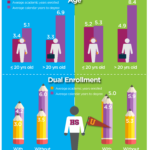
Time to Degree – 2016
This report examines time to degree completion for a cohort of students who earned an associate degree as their first and only postsecondary degree or a bachelor’s degree as their first four-year degree between July 1, 2014, and June 30, 2015. Overall, the average time enrolled for associate and bachelor’s degree earners was 3.3 years and 5.1 years, respectively. However, as the report shows, the time required for successful degree attainment could be influenced by the pathway the student followed as well as by factors, such as stop outs and less than full-time enrollment status.
Suggested Citation: Shapiro, D., Dundar, A., Wakhungu, P.K., Yuan, X., Nathan, A, & Hwang, Y. (2016, September). Time to Degree: A National View of the Time Enrolled and Elapsed for Associate and Bachelor’s Degree Earners (Signature Report No. 11). Herndon, VA: National Student Clearinghouse Research Center.
Table of Contents
- About This Report
- Introduction and Purpose of the Report
- Results
- Discussion
- Major Findings
- Enrolled Time to Degree
- Elapsed Time to Degree
- Differences in Time to Degree by Age
- Time to Degree for Bachelor’s Degree Earners with/without a Prior Associate Degree or Prior Enrollments in Two-Year Institutions
- Time to Degree for Degree Earners with/without Dual Enrollment
- Enrolled Time to Degree by Elapsed Time
- Time to Degree and Number of Institutions Attended
- Time to Degree and Number of Stop Outs
- Final Thoughts and Implications
- Major Findings
- References
- Appendix A: Methodological Notes
- Appendix B: Coverage Tables
- Appendix C: Results Tables
About This Report
AUTHORS
National Student Clearinghouse Research Center
- Doug Shapiro
- Afet Dundar
Project on Academic Success, Indiana University
- Phoebe Khasiala Wakhungu
- Xin Yuan
- Angel Nathan
- Youngsik Hwang
ACKNOWLEDGEMENTS
The authors would like to thank Victor Borden, director of Project on Academic Success and Professor of Higher Education and Student Affairs at Indiana University Bloomington for his thoughtful comments and suggestions; and the team members of the National Student Clearinghouse Research Center, Faye Huie for her assistance with editing sections of the report and Joe Bloom for his work to make the Clearinghouse data analysis ready.
SPONSOR
This report was supported by a grant from the Lumina Foundation. Lumina Foundation, an Indianapolis-based private foundation, is committed to enrolling and graduating more students from college — especially 21st century students: low-income students, students of color, first-generation students and adult learners. Lumina’s goal is to increase the percentage of Americans who hold high-quality degrees and credentials to 60 percent by 2025. Lumina pursues this goal in three ways: by identifying and supporting effective practice, through public policy advocacy, and by using our communications and convening power to build public will for change. For more information, log on to www.luminafoundation.org.
Introduction and Purpose of the Report
The time between initial enrollment in a postsecondary institution and graduation with a college degree is considered to be an important indicator of student success (California Postsecondary Education Commission, 2006). Traditionally, students were considered successful when they graduated “on time,” which meant within two years or four years at a two- or four-year degree-granting institution, respectively. However, for a majority of postsecondary students, time-to-degree completion has increased over the past 30 years (Bound, Lovenheim, & Turner, 2012; Knight, 2002, 2004). Trends in the late 1970s highlighted higher education students’ increased time to degree (California Postsecondary Education Commission, 1988). In fact, the Complete College America (2014) report revealed that less than 50 percent of full-time students graduate within four years at public four-year institutions. The proportion of “on time” graduation at community colleges was even lower, with only 5 percent of students who started out with full-time course loads graduating with an associate degree within two years.
The change in traditional timelines for college completion can become expensive when viewed in terms of college costs, taxpayers’ subsidies, and the wages students forfeit with each additional semester of enrollment (DesJardins, Ahlburg, & McCall., 2002; Gilmore & Hoffman, 1997). Although the majority of postsecondary students are now taking longer to complete college, extended periods of enrollment are even more common for students who are academically unprepared at the start (Bound, Lovenheim, & Turner, 2012).
Previous research highlighted various complex factors linked to increases in time to degree. They include reduced institutional resources available to students; rising college costs (Bound, Lovenheim, & Turner, 2012); remediation requirements (Bettinger, 2008; Ishitani, 2006; The Campaign for College Opportunity, 2014); taking more courses than is required, enrolling in non-degree classes, and difficulty in getting required courses (The Campaign for College Opportunity 2014); changing majors (California Postsecondary Education Commission, 1988); need for employment (Bound, Lovenheim, & Turner, 2012; California Postsecondary Education Commission, 1988; The Campaign for College Opportunity, 2014); and reduced course loads (Knight, 2002, 2004); among other factors.
This report builds upon the previous findings and expands them to include enrollments across multiple institutions (as opposed to considering only terms from the same school where the degree was earned) and provides the outcomes for different subgroups of students by age, gender, and enrollment intensity. Overall, a number of goals guided this report: 1) explore the various enrollment pathways of students who received a bachelor’s and/or an associate degree, as growing numbers of students transfer and graduate elsewhere; 2) determine how these pathways influenced the time required for successful degree attainment; and 3) examine the effects of the growing prevalence of student enrollment behaviors that include periods of stop out and enrollments at less than full-time status.
Using student-level data from the National Student Clearinghouse (NSC), we measured time to degree with two different metrics: 1) the time that elapsed between students’ first term date and degree award date and 2) the total time of active enrollment. Understanding enrollment pathways can help administrators develop interventions to help students more successfully and quickly complete a degree. Reducing time to degree will likely increase graduation rates, as well as other costs related to extended time in college (Attewell & Monaghan, 2016; Jones, 2015). However, we also recognize that a longer time to degree may not be solely in control of the institutions or policymakers. It may also be an effect of the changing economic, social, and cultural circumstances of students. For this reason, our hope is that the potential impact of the report is not limited to developing measures to reduce time to degree. We would also like it to provide a means by which policymakers gain insight into better serving the needs of students who are not on the traditional path and avoid considering them to be “failures” simply because they took a longer time to finish.
LITERATURE REVIEW
Various studies have identified factors that contribute to increased time-to-degree completion. One of these factors includes the increased need for remedial education programs (Bettinger & Long 2009; Ishitani, 2006). At community colleges, about 60 percent of incoming freshmen are placed into at least one remedial course, with many having multiple areas of remediation needs (Bailey & Cho, 2010). Although remediation plays an important role in addressing the needs of underprepared students, the additional curricular requirements will likely increase time to degree while decreasing the likelihood of college completion (Bettinger & Long, 2009). This issue is especially impactful on community college students, who are already graduating at lower rates than their counterparts at four-year institutions (Bailey & Cho, 2010; Complete College America, 2014; Proudfit, 2014). Furthermore, the dissonance between community college and four-year institutions’ curricular offerings results not only in a loss of credits, but also highlights the transitional issues between academic environments and cultures in higher education (Johnson, 2011).
Other studies have shown that students who began postsecondary education at less selective public universities and community colleges and those with a greater financial need had the longest time to degree (Astin, 2006; Bound, Lovenheim, & Turner, 2012., 2012; Messer & Wolter, 2010; Oseguera, 2006; Runyan, 2011; Wei & Horn, 2009). Specifically, students may have difficulty affording a full course load due to increasing college costs and limited federal and state financial assistance (Lau, 2003). To ameliorate financial hardships, students seek paid employment to pay their way through college (Bound, Lovenheim, & Turner, 2012, Johnson, 2011), which can increase time-to-college completion as well as distract students from college studies. Although factors, such as financial aid, have been examined to determine whether they affect time to degree, the findings have been inconclusive. For instance, Lam (1999) found that students who took loans to pay for their educational expenses, but had no employment, took less time to graduate than those who took loans and were employed. However, Knight and Arnold (2000) found that receiving need-based and non-need-based loans slightly increased semesters enrolled to degree, but decreased semesters elapsed.
In terms of enrollment intensity, researchers generally agree that full-time continuously enrolled students are more likely to graduate than part-time discontinuously enrolled students (Belcheir, 2000; Camara, 2003; Jones, 2015; O’Toole, Stratton, & Wetzel, 2003). However, there are also variations within full-time status that differentially impact time to degree. For instance, Volkwein and Lorang (1996) found that full-time students who enrolled in less than 15 credits took more than four years to graduate than those full-time students with heavier course loads. Some of the reasons for extended time to degree were linked to outside employment and family responsibilities. Equally, for the increasing number of postsecondary students who transfer between institutions before earning a degree such mobility, due to course and credit transferability issues, can increase time to degree (Anderson, 2015; Borden, 2004; Bradburn, Beger, Xiaojile, Katharin, & Rooney, 2003; Friedel & Wilson, 2015; Hossler et al., 2012; Marling, 2013; Shapiro et al., 2015).
In an effort to limit time to degree, some states and institutions have restructured institutional and legislative policies (Contomichalos, 2014; Johnson, 2011). Florida has attempted to address these issues by passing legislation to standardize degree requirements, in an effort to increase the transferability of credits across state institutions (LeMon & Pitter, 1996). With over 600 degree programs requiring different credit hours to degree completion, Florida has also reduced the requirements in most bachelor’s degree programs to 120 credit hours to help students avoid accumulating unnecessary credits (Pitter, LeMon & Lanham, 1996). Indiana has created an online library that provides a list of courses that transfer among all Indiana public colleges (Indiana Core Transfer Library, 2016). In addition to legislative policy changes, institutions are beginning to provide course selection resources, such as program maps, to help students determine which courses count towards their degree and which do not (Degree Road Maps, 2016). Others have outreach programs targeting student populations with lower persistence and graduation rates (California Postsecondary Education Commission, 2006).
In general, researchers and institutional leaders agree that time to degree is an important topic to address as an indicator of student success. In line with the completion agenda, understanding the average time to degree and the pathways that students pursue may help institutional leaders and policymakers reevaluate present policies in place to facilitate the U.S.’s progress toward the goal of achieving the highest proportion of college graduates in the world by 2020 (Obama, 2009).
A NOTE ON THE DATA
The report describes students’ pathways to degree completion for a cohort of students who earned an associate degree as their first and only postsecondary degree or a bachelor’s degree as their first four-year degree between July 1, 2014, and June 30, 2015. Only degrees from schools for which the Clearinghouse had enrollment records for at least the prior 10 years were retained in the cohort.
Data Source
The data for this report were drawn from the StudentTracker® and DegreeVerifySM services, administered by the National Student Clearinghouse® (the Clearinghouse), which tracks college enrollments nationwide across all postsecondary institutions, including all institution types: two-year and four-year institutions, public and private institutions, and nonprofit and for-profit institutions. The National Student Clearinghouse® (the Clearinghouse) is a unique and trusted source for higher education enrollment and degree verification. Currently, Clearinghouse data include more than 3,600 postsecondary institutions and 96.5 percent of U.S. postsecondary enrollments. The Clearinghouse has a 23-year track record of providing automated student enrollment and degree verifications. Due to the Clearinghouse’s unique student-level record approach to data collection, the Clearinghouse data provides opportunities for robust analysis not afforded by the more commonly used institution-level national databases.
Time-to-Degree Definition
Time to degree was defined in two different ways:
- Time elapsed was defined as the total time, in calendar years, between initial enrollment in a postsecondary institution and subsequent degree attainment, regardless of whether or not the student was actually enrolled.
- Time enrolled was defined in terms of the number of weeks that are equivalent to one academic year (30 weeks) of active, full-time enrollment. For example, four semesters of full-time enrollment are equivalent to two academic years of enrollment whereas four semesters of half-time enrollment are equivalent to one year of enrollment. See Appendix A for more on the advantages and limitations of defining the enrolled time in terms of academic years.
Dual enrollments, which are enrollments before the student was 18 years old, were not included in either definition. (For a full discussion of data, definitions, and limitations, please see Appendix A.)
Figure I1 shows the distribution of associate and bachelor’s degrees among the degree earners included in the cohort.
Figure I2 shows the distribution of degree earners by degree level and institution type.
Figure I3 shows the distribution of associate and bachelor’s degree earners by age at first entry.
For a full description of the cohort, please see Appendix C.
Results
OVERALL PATTERNS
The results are reported for students who received their first associate and/or bachelor’s degrees between July 1, 2014, and June 30, 2015 (N = 2,047,696). Time-to-degree analyses on associate (N = 573,014) and bachelor’s (N = 1,474,682) degree recipients were conducted separately.
Two strategies were used to define time to degree: time enrolled (number of academic years defined as 30 weeks of full-time or full-time equivalent enrollment) and time elapsed (number of calendar years between the first term begin date and the date of degree completion). More on data definitions can be found in Appendix A.
Figures 1 through 5 show outcomes for degree earners by:
- Institution type
- Age and institution type
- Gender and institution type
Overall, analysis showed that the average time enrolled for associate and bachelor’s degree earners was 3.3 years and 5.1 years, respectively. The average elapsed time was 5.5 years for associate and 5.7 years for bachelor’s degree earners (see Figure 1 for average time to degree for specific institution types). All associate and bachelor’s degree earners, except those at four-year private nonprofit institutions, remained enrolled for an average of one year or more on top of the prescribed “on time graduation” definition of two or four year institutions. In fact, among associate degree earners from two-year public institutions, only 14.7 percent received their degrees in two calendar years and only 7.4 percent had two academic years of full-time or full-time equivalent enrollment. Among bachelors’ degree earners from four-year public institutions, 37.5 percent received their degrees in four calendar years and only 10.1 percent had four academic years of full-time or full-time equivalent enrollment (for selected results, see Tables R1 and R2 below; for complete results, see Tables 7-10 in Appendix C).
Table R1. Distribution of Associate Degree Earners from Two-Year Public Institutions by Total Time Elapsed (N=419,317)
| n | % | |
| 2 Years | 61,623 | 14.7% |
| 3 Years | 85,832 | 20.5% |
| 4 Years | 64,561 | 15.4% |
| 5-6 Years | 77,011 | 18.4% |
| More than 6 Years | 130,290 | 31.1% |
Table R2. Distribution of Bachelor’s Degree Earners from Four-Year Public Institutions by Total Time Elapsed (N=1,020,430)
| n | % | |
| 4 Years | 382,565 | 37.5% |
| 5 Years | 264,678 | 25.9% |
| 6 Years | 121,960 | 12.0% |
| 7-8 Years | 105,896 | 10.4% |
| More than 8 Years | 145,331 | 14.2% |
Among four-year institutions, those at four-year private for-profit institutions, showed the highest average elapsed time in calendar years (8.8 years) and average enrolled time in academic years (5.8 years) to degree (Figure 1). At four-year public and four-year private nonprofit institutions, both traditional-age students and students 20 or older at first entry, were enrolled for an average of 4.8 academic years. At four-year private for-profit institutions, younger students had the highest average elapsed time (10.2 years), in comparison to those at four-year public or private nonprofit institutions. Interestingly, average time enrolled was similar to average elapsed time for students age 20 or younger who attended four-year public or four-year private nonprofit institutions (Figure 2). In general, regardless of institution type, men and women had similar average enrolled and elapsed time suggesting little gender differences in time-to-degree (Figure 3).
In general, associate and bachelor’s degree earners’ average time enrolled increased as the elapsed time in calendar years increased, regardless of the institution type (Figures 4 and 5). When the elapsed time increased from four calendar years to five calendar years, the average enrolled time also increased from slightly over four academic years to slightly over five academic years. The increase in the average enrolled time was not as dramatic when the elapsed time increased from five to six or more calendar years.
Figure 1. Time to Degree for Associate (N=573,014) and Bachelor’s (N=1,474,682) Degree Earners by Type of Institution where Degree was Received*
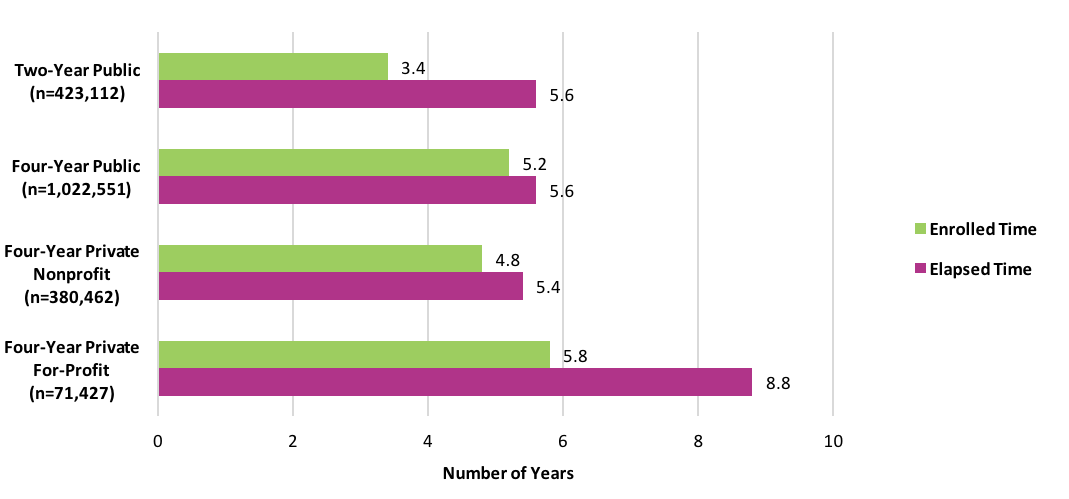
*This figure is based on data shown in Appendix C, Table 1a and Table 2a.
Figure 2. Time to Degree for Associate (N=564,263) and Bachelor’s (N=1,470,652) Degree Earners by Age and Type of Institution where Degree was Received*

*This figure is based on data shown in Appendix C, Table 1b and Table 2b.
Note: Students with missing age data were excluded from the above figure.
Figure 3. Time to Degree for Associate (N=540,117) and Bachelor’s (N=1,384,497) Degree Earners by Gender and Type of Institution where Degree was Received*
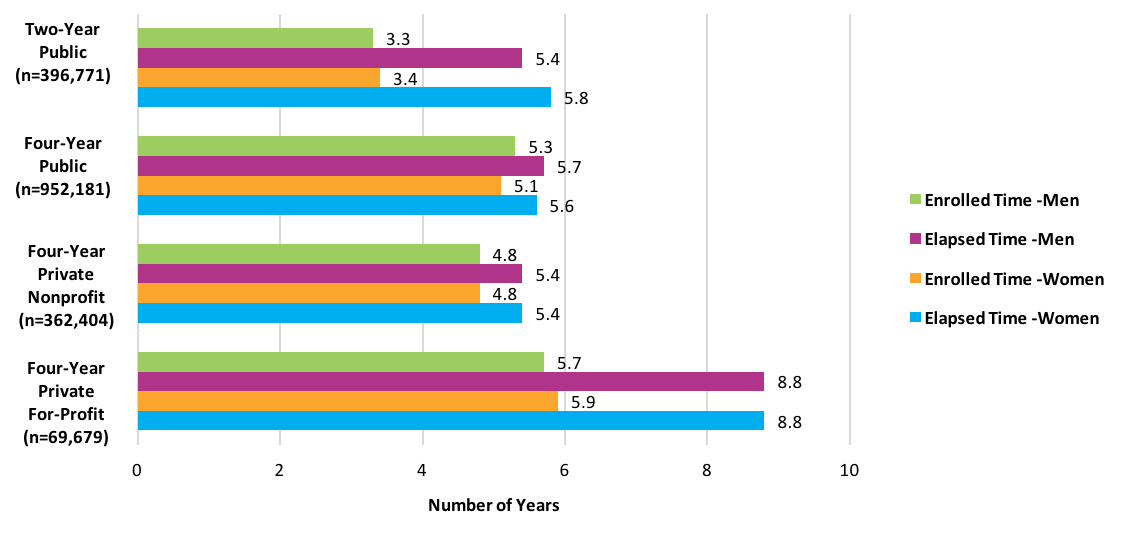
*This figure is based on data shown in Appendix C, Table 1c and Table 2c.
Note: Students with missing gender data were excluded from the above figure.
Figure 4. Average Enrolled Time by Total Elapsed Time for Two-Year Public Associate Degree Earners (N=419,317)*
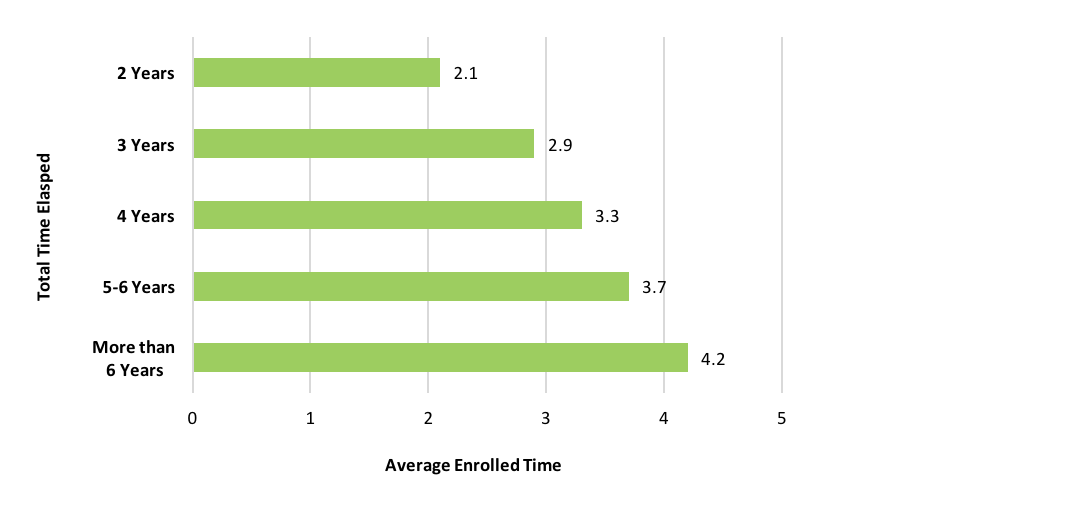
*This figure is based on data shown in Appendix C, Table 22a.
Figure 5. Average Enrolled Time by Total Elapsed Time for Bachelor’s Degree Earners (N=1,474,536)*
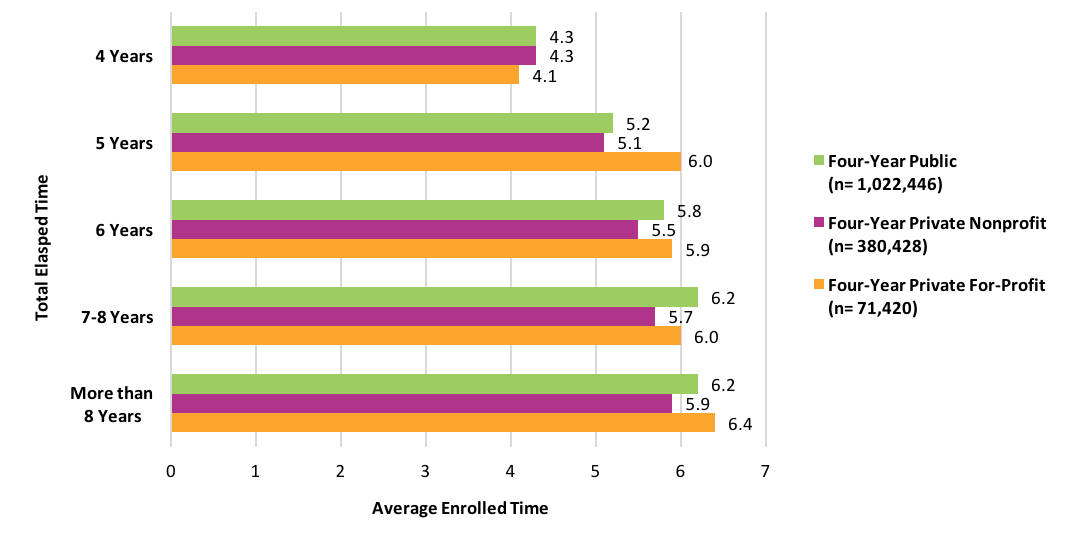
*This figure is based on data shown in Appendix C, Table 22b.
AVERAGE TIME TO DEGREE WITH/WITHOUT AN ASSOCIATE DEGREE
On average, time to degree was extended for students who had an associate degree prior to receiving their bachelor’s, both in terms of time enrolled and time elapsed regardless of the institution type (Figure 6). The average time of active enrollment was higher for those who graduated with an associate degree than without one (5.7 years and 5.0 years, respectively). The difference in average time elapsed was even more dramatic: students with an associate degree took 8.2 years to graduate with a bachelor’s degree, whereas students without an associate degree took 5.1 years, resulting in a 3.1 year difference between those with and without an associate degree.
It should be noted, however, that the bachelor’s degree earners who had no prior associate degree may or may not have been transfer students in this report. Bachelor’s degree earners in this study might have been native students to the four-year institution where they received their degree. For this reason, we also examined time to degree separately for those bachelor’s degree earners with and without prior enrollment in two-year institutions, if they had no prior associate degree.
For bachelor’s degree earners without a prior associate degree but with prior two-year enrollments, the average time of active enrollment was 5.3 academic years completed in 6.0 calendar years while for their peers without any prior two-year enrollments, the average enrolled time was 4.8 academic years completed in 4.5 calendar years (see Table 3b.2, Appendix C) .
Figure 6. Time to Degree for Bachelor’s Degree Earners with/without an Associate Degree by Type of Institution where Bachelor’s Degree was Received (N=1,474,682)*

*This figure is based on data shown in Appendix C, Table 3a.1.
Figure 7. Time to Degree for Bachelor’s Degree Earners with/without an Associate Degree by Age and Type of Institution where Bachelor’s Degree was Received (N=1,470,652)*
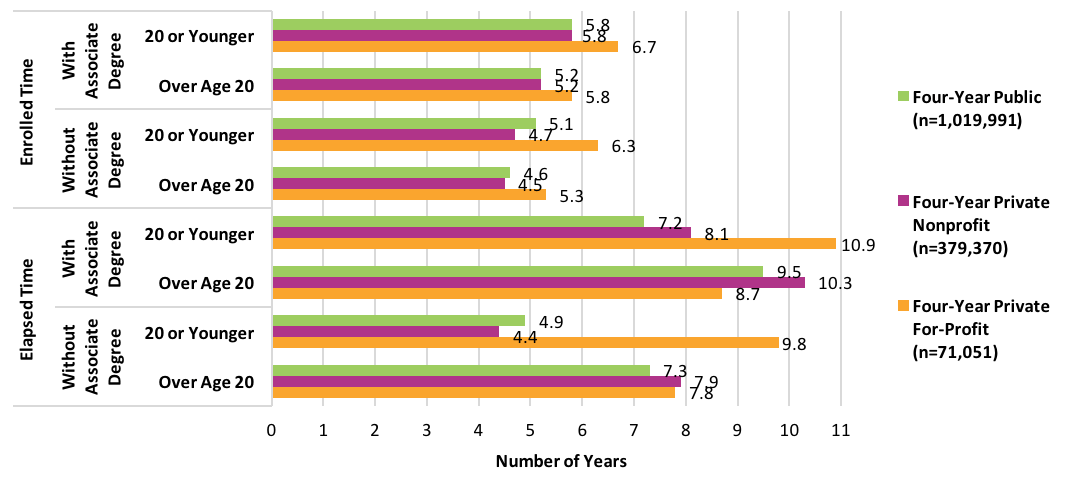
*This figure is based on data shown in Appendix C, Table 3b.
Note: Students with missing age data were excluded from the above figure.
When results were disaggregated by age, degree earners who were at traditional age at first entry and without an associate degree were, on average, enrolled for a shorter time than those with an associate degree, regardless of the institution type (Figure 7). In general, for both age groups, the average time elapsed was higher among students with an associate degree than those without. The two highest elapsed times were among bachelor’s degree recipients from four-year private for-profit institutions who entered college at a traditional college age (10.9 calendar years to degree) and bachelor’s degree recipients from four-year public institutions entering college later in life (9.5 calendar years to degree) (Figure 7).
AVERAGE TIME TO DEGREE WITH/WITHOUT PRIOR DUAL ENROLLMENT
Figures 8 and 9 present the time-to-degree findings for associate and bachelor’s degree earners with or without prior dual enrollment. Overall, results indicated that former dual enrolled students had a shorter time to degree, both in terms of average years enrolled and elapsed, than students who were not dually enrolled. This was an expected result given that dual enrolled students earn some college credits prior to entering a postsecondary institution. For associate degree earners, on average, time enrolled was shorter for those who had prior dual enrollment (3.0 years) than those without (3.5 years, Figure 8). Average elapsed time in calendar years, was longer for associate degree earners without dual enrollment (6.0 years) than those with dual enrollment (4.2 years) (Figure 8).
When the relationship between dual enrollment and time to degree was examined by institution type (Figure 9), the average enrolled time was higher among degree earners from private for-profit institutions, both with and without prior dual enrollment (6.0 and 5.8 years, respectively), compared to those who had completed their degree at a public or private nonprofit institution, regardless of dual enrollment status (i.e., 4.6 to a maximum of 5.3 years). Further, the average time elapsed showed the same trend among bachelor’s degree earners from four-year institutions. For example, students with and without prior dual enrollment from four-year private for-profit institutions had on average much higher elapsed time (8.6 years and 8.9 years, respectively), than students who earned their degrees from four-year public or four-year private nonprofit institutions (i.e., from 4.5 to a maximum of 5.9 average years).
Figure 8. Time to Degree for Two-Year Public Associate Degree Earners with/without Dual Enrollment (N=420,539)*
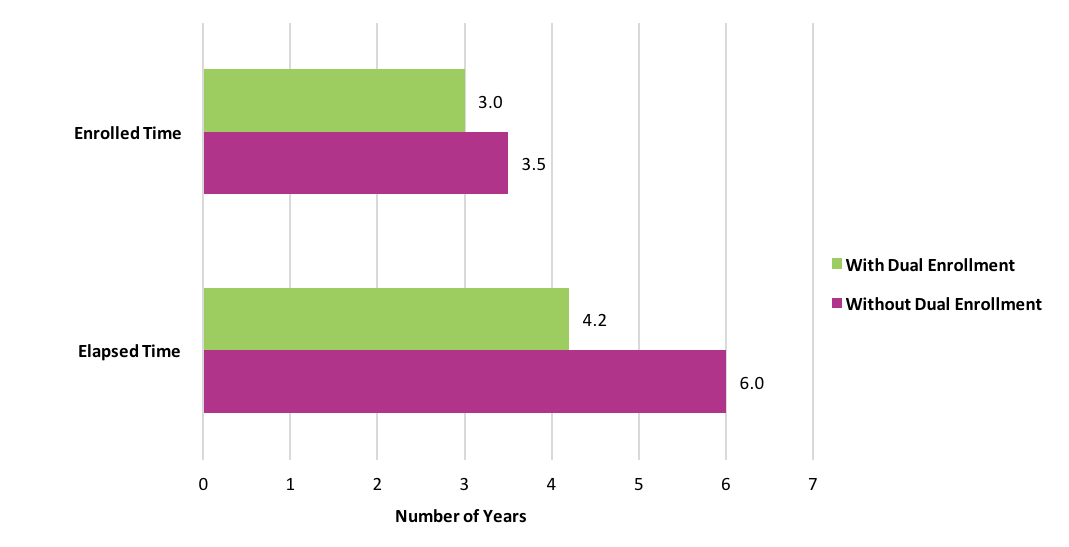
*This figure is based on data shown in Appendix C, Table 5a.
Figure 9. Time to Degree for Bachelor’s Degree Earners with/without Dual Enrollment by Type of Institution where Degree was Received (N=1,472,405)*
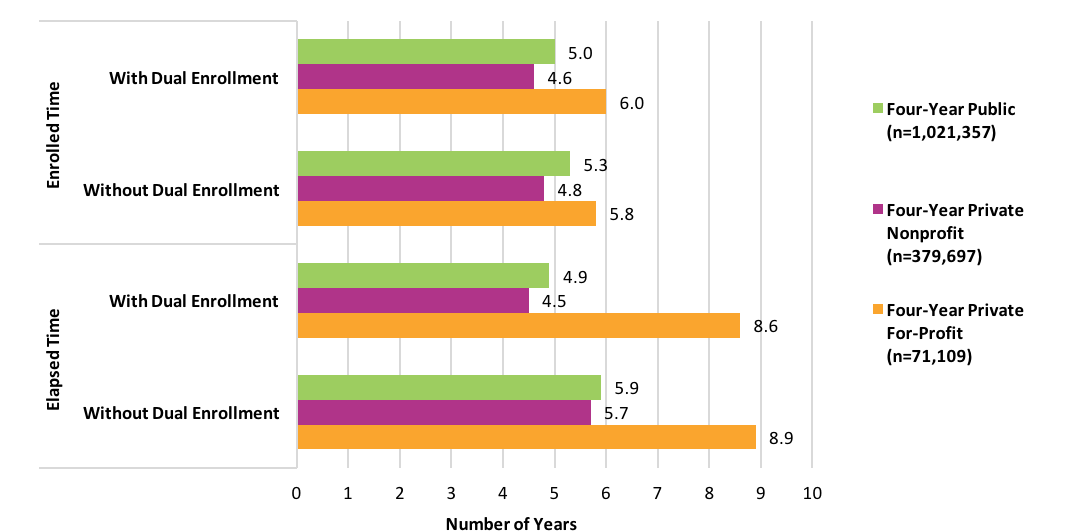
*This figure is based on data shown in Appendix C, Table 5f.
TOTAL ENROLLED TIME AND NUMBER OF INSTITUTIONS ATTENDED
Figures 10 through 15 show the number of institutions attended by associate and bachelor’s degree earners from two-year public, four-year public and four-year private institutions for different categories of enrolled time. The results consistently show a multiple-institution attendance pattern for all degree earners. For example, even among those associate degree earners who had two academic years of enrollment, more than one in four attended two or more institutions (Figure 10). Fewer than half of bachelor’s degree earners from four-year public institutions attended only one institution (43.4 percent) (Figure 12).
While the pattern of multiple institution attendance holds regardless of age at first entry or institution type, there are many differences in the proportion of degree earners who attended one versus more than one institution, depending on the age at first entry (Figures 11 and 13).
Figure 10. Percentage of Associate Degree Earners from Two-Year Public Institutions by Total Enrolled Time and Number of Institutions Attended (N=420,209)*
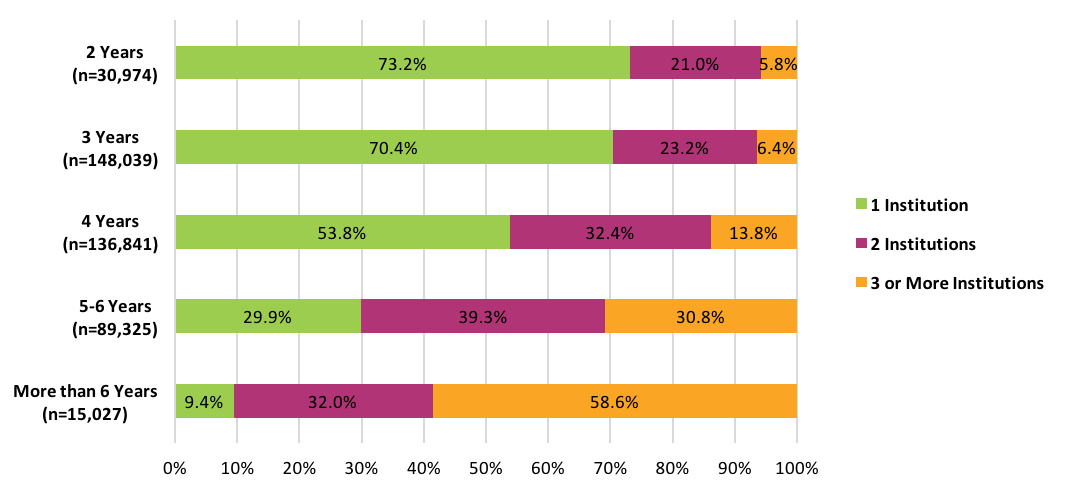
*This figure is based on data shown in Appendix C, Table 6a.
Figure 11. Percentage of Associate Degree Earners from Two Year Public Institutions by Total Enrolled Time, Number of Institutions Attended and Age (N=416,992)*
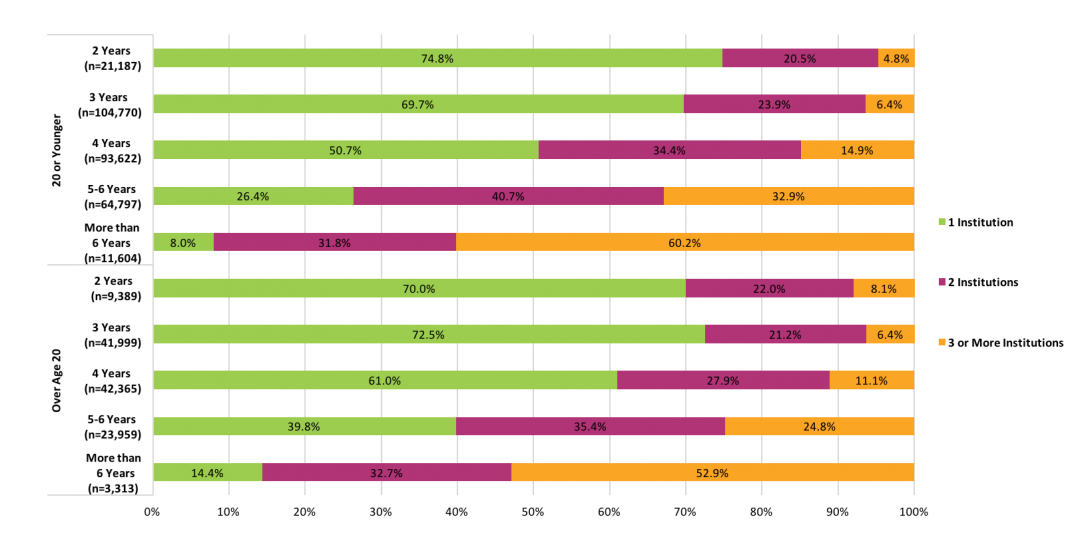
*This figure is based on data shown in Appendix C, Table 6b.
Note: Students with missing age data were excluded from the above figure.
Figure 12. Percentage of Bachelor’s Degree Earners from Four-Year Public Institutions by Total Enrolled Time and Number of Institutions Attended (N=1,022,446)*
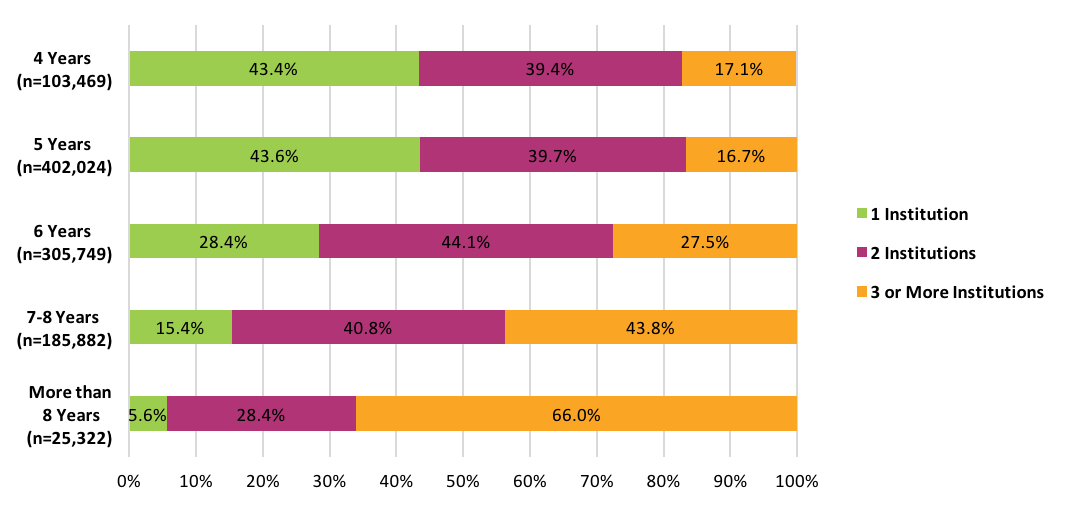
*This figure is based on data shown in Appendix C, Table 8a.
Figure 13. Percentage of Bachelor’s Degree Earners from Four-Year Public Institutions by Total Enrolled Time, Number of Institutions Attended and Age (N=1,019,991)*
*This figure is based on data shown in Appendix C, Table 8b.
Note: Students with missing age data were excluded from the above figure.
Figure 14. Percentage of Bachelor’s Degree Earners from Four-Year Private Nonprofit Institutions by Total Enrolled Time and Number of Institutions Attended (N=380,428)*
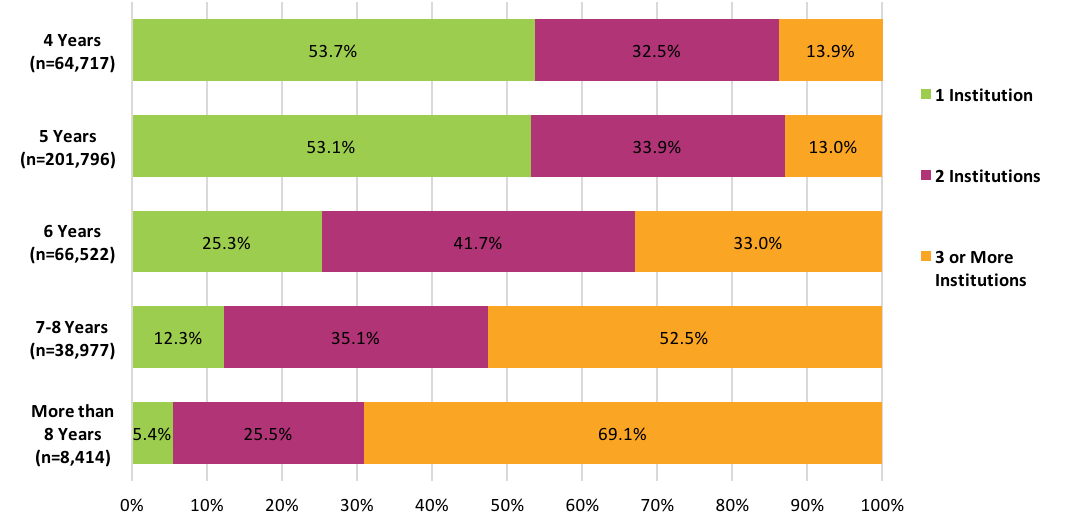
*This figure is based on data shown in Appendix C, Table 10a.
Figure 15. Percentage of Bachelor’s Degree Earners from Four-Year Private For Profit Institutions by Total Enrolled Time and Number of Institutions Attended (N=71,420)*
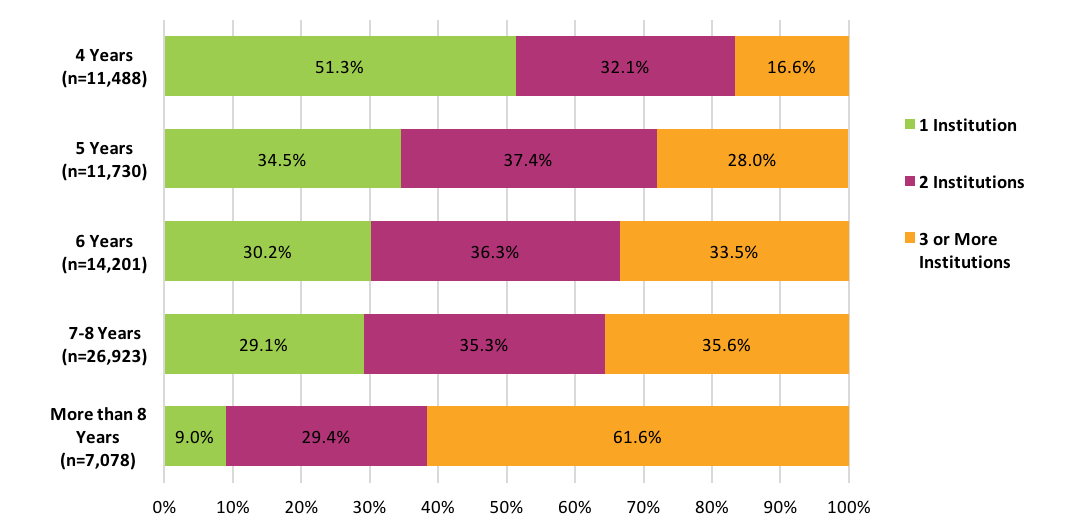
*This figure is based on data shown in Appendix C, Table 12a.
TOTAL TIME ENROLLED AND NUMBER OF STOP OUTS
Figures 16 through 23 are in reference to the percentage of degree earners by total time enrolled and number of stop outs for associate and bachelor’s degree earners. Overall, regardless of age and institution type, number of stop outs and time to degree were positively related, where a higher number of stop outs resulted in a higher time to degree. For example, out of all bachelor’s degree earners from four-year public institutions with five academic years of total enrolled time 73.1 percent did not stop out at all whereas 3.7 percent had at least three or more stop outs. In contrast, among those with eight or more academic years of enrolled time, fewer than a quarter (23.9 percent) had no stop outs, while slightly over half (51.3 percent) had two or more stop outs (Figure 18 below, also see Tables 14-21, Appendix C for further details).
Disaggregating the total time enrolled and number of stop outs by age at first entry into college shows that among bachelor’s degree earners from four-year public or private nonprofit institutions, a higher proportion of traditional-age students completed their degree without any stop outs than students who started college later in life, regardless of the time of active enrollment. For example, among bachelor’s degree earners from four-year public institutions who had four academic years of active enrollment, 63.6 percent of those who started college at a traditional age had no stop outs versus 48.8 percent of those who were over 20 when they started (Figure 21).
This pattern was reversed among bachelor’s degree earners from four-year private for-profit institutions: specifically, a higher proportion of students over age 20 had no stop outs in each category of total time enrolled (whether it was four academic years, five academic years, etc.) than those students who were of a traditional age at first entry (see this report’s Discussion and Appendix C for more on stop outs by elapsed time).
Figure 16. Percentage of Associate Degree Earners from Two-Year Public Institutions by Total Enrolled Time and Number of Stop-outs (N=420,209)*

*This figure is based on data shown in Appendix C, Table 14a.
Figure 17. Percentage of Associate Degree Earners from Two-Year Public Institutions by Total Enrolled Time, Number of Stop-outs and Age (N=416,992)*
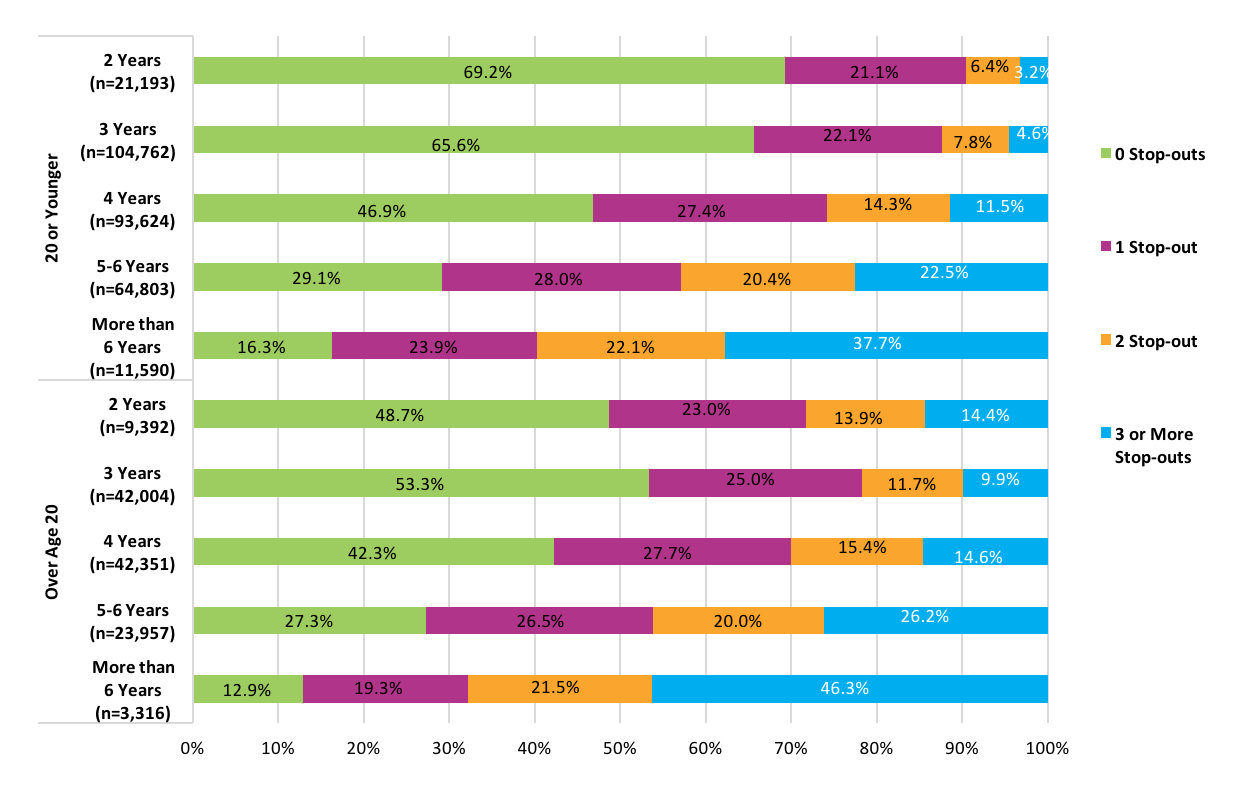
*This figure is based on data shown in Appendix C, Table 14b.
Note: Students with missing age data were excluded from the above figure.
Figure 18. Percentage of Bachelor’s Degree Earners from Four-Year Public Institutions by Total Enrolled Time and Number of Stop-outs (N=1,022,446)*
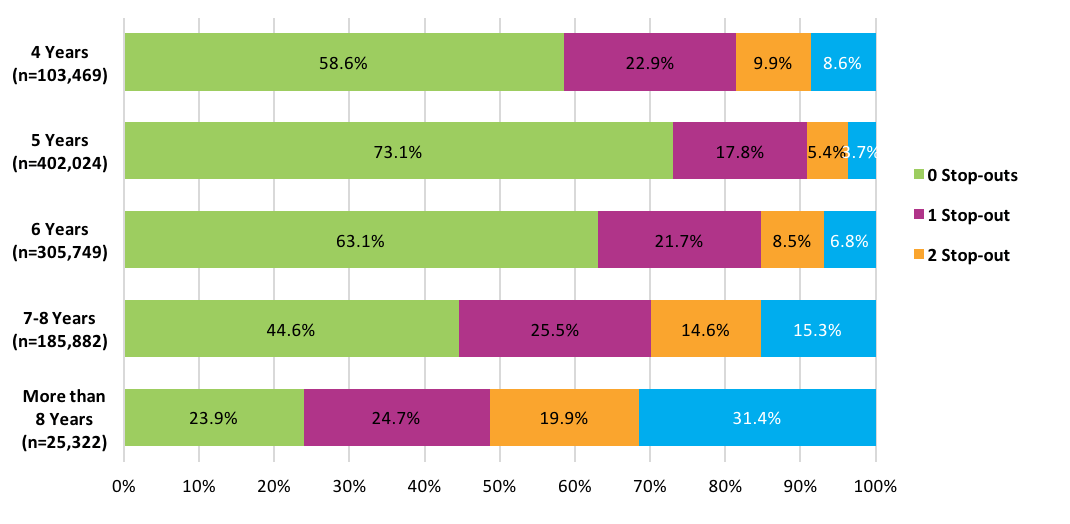
*This figure is based on data shown in Appendix C, Table 16a.
Figure 19. Percentage of Bachelor’s Degree Earners from Four-Year Public Institutions by Total Enrolled Time, Number of Stop-outs and Age (N=1,019,991)*
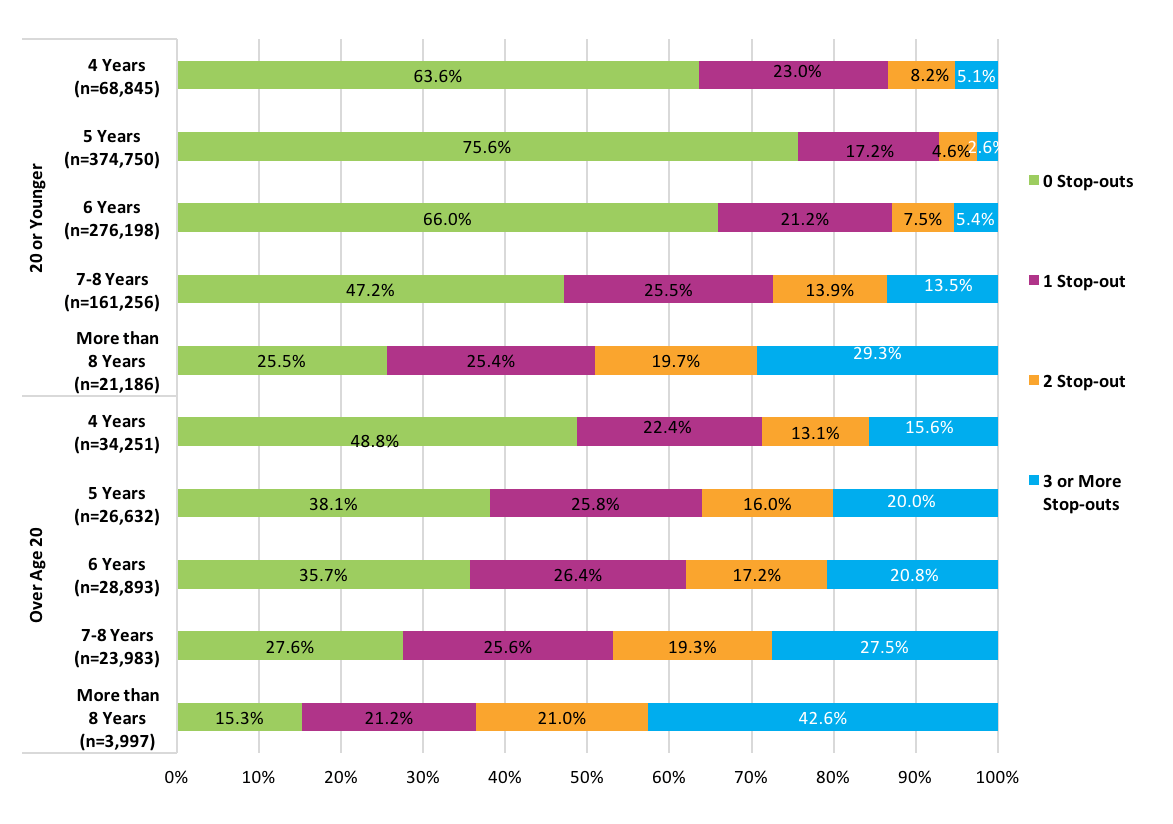
*This figure is based on data shown in Appendix C, Table 16b.
Figure 20. Percentage of Bachelor’s Degree Earners from Four-Year Private Nonprofit Institutions by Total Enrolled Time and Number of Stop-outs (N=380,428)*
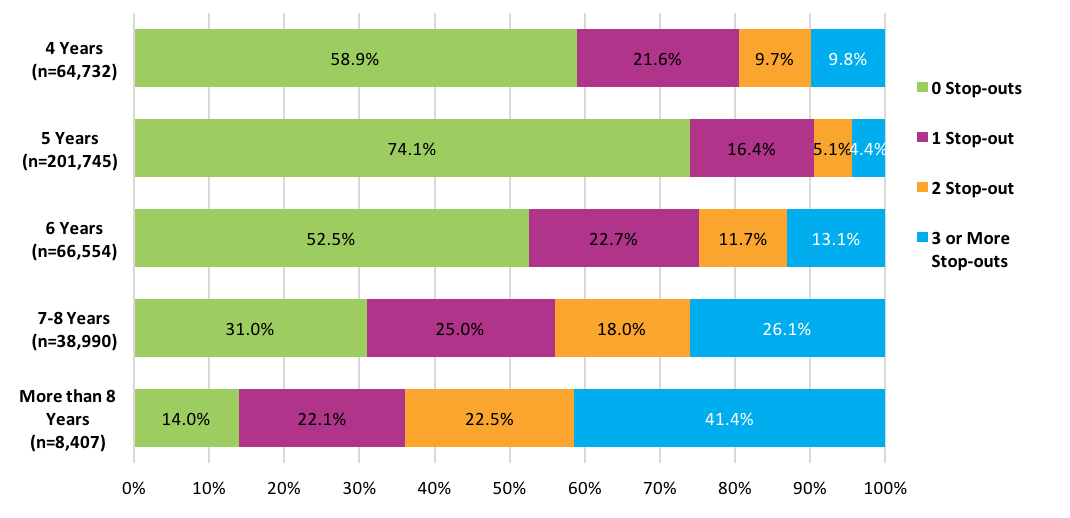
*This figure is based on data shown in Appendix C, Table 18a.
Figure 21. Percentage of Bachelor’s Degree Earners from Four-Year Private Nonprofit Institutions by Total Enrolled Time, Number of Stop-outs and Age (N=379,370)*
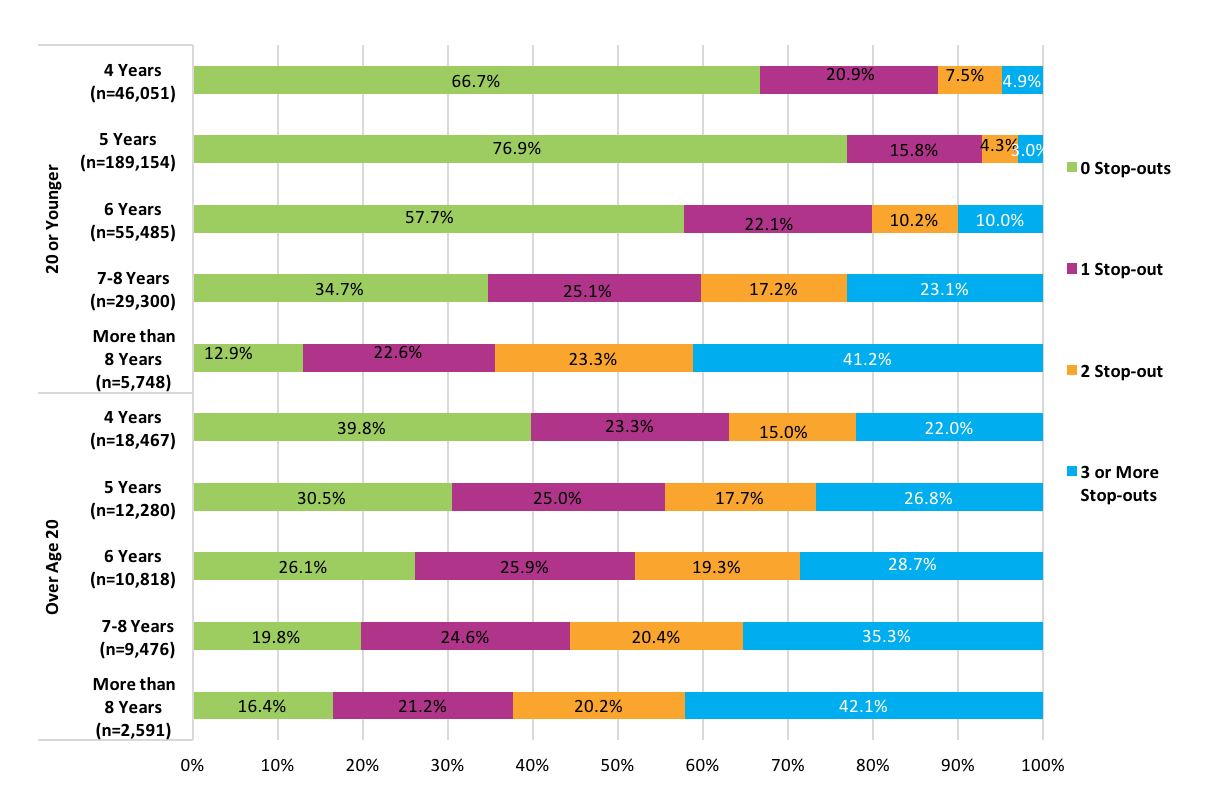
*This figure is based on data shown in Appendix C, Table 18b.
Note: Students with missing age data were excluded from the above figure.
Figure 22. Percentage of Bachelor’s Degree Earners from Four-Year Private For-Profit Institutions by Total Enrolled Time and Number of Stop-outs (N=71,420)*
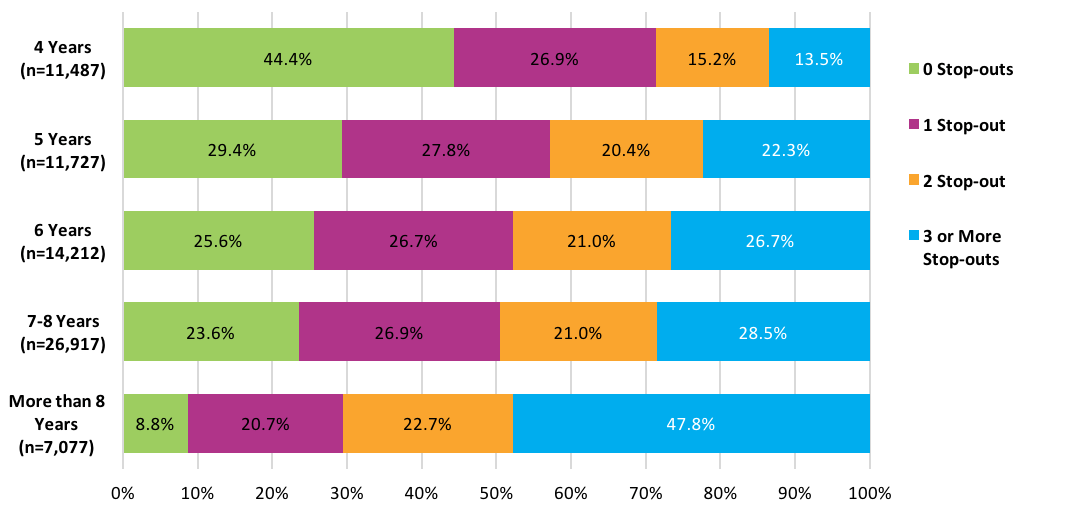
*This figure is based on data shown in Appendix C, Table 20a.
Figure 23. Percentage of Bachelor’s Degree Earners from Four-Year Private For-Profit Institutions by Total Enrolled Time, Number of Stop-outs and Age (N=71,051)*
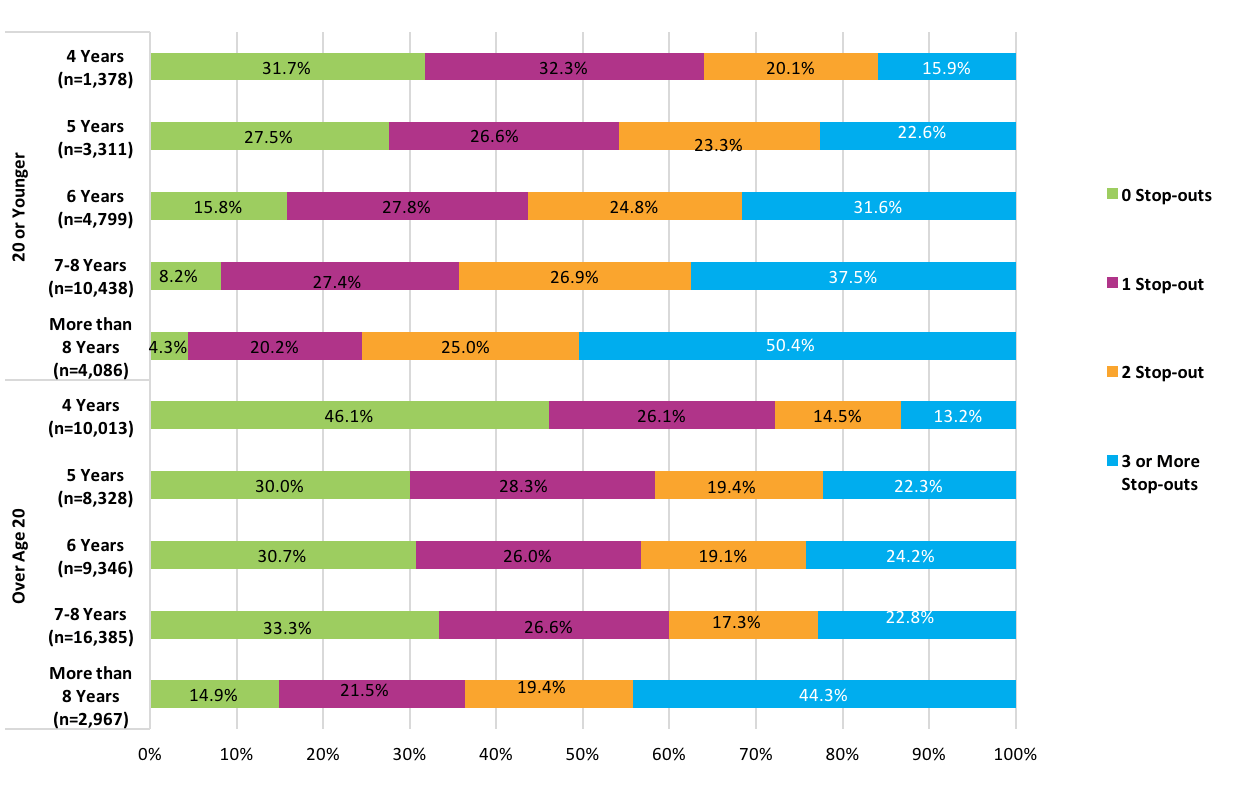
*This figure is based on data shown in Appendix C, Table 20b.
Note: Students with missing age data were excluded from the above figure.
Discussion
Time to degree has long been viewed as an important outcome for research and policy. It is an important consideration for students, parents, institutions, and states because of the financial implications the length of enrollment can have on each of these stakeholders. While the emergence of massive open online courses (MOOC) and the flexibility offered by online programs has expanded how postsecondary credentials are defined, for the most part, there is still a certain length of time perceived as the norm for receiving an associate or bachelor’s degree. This expectation not only determines the length of time institutions are allowed to use to measure student success (typically, 150 percent of “normal” time), it also limits our understanding of time to degree thereby rendering students who take longer to finish invisible. As a result, when student completion rates decline, for example, it is difficult to know whether more students are actually dropping out or simply taking longer to graduate than the standard data measurement allows. This report captures all degree earners within a given year, regardless of how long it took them, providing a more complete picture of student success overall and, in particular, that of non-traditional students.
MAJOR FINDINGS
Enrolled Time to Degree
Today’s students take more than two years to earn an associate degree: 3.3 academic years of full-time or full-time equivalent enrollment, on average. Bachelor’s degree earners take more than four years to finish: 5.1 academic years, on average. The average length of enrollment for bachelor’s degree earners from four-year public institutions, 5.2 academic years, is slightly longer than that of their peers from four-year private nonprofit institutions (4.8 academic years), but shorter than the 5.8 academic years for students who received a bachelor’s degree from four-year private for-profit institutions.
Only 7.4 percent of associate degree earners from two-year public institutions, fewer than one in 13, finished their degree within two academic years of full-time or full-time equivalent enrollment. Another 35.2 percent finished within three academic years of enrollment. More than half of associate degree earners finished their degree within four or more academic years of enrollment.
Just 10 percent of bachelor’s degree earners from four-year public institutions finished their degree within four academic years of full-time or full-time equivalent enrollment and 39.3 percent finished within five academic years. Half of all bachelor’s degree earners from four-year public institutions finished their degree within six or more academic years of enrollment.
Caution is warranted in interpreting the small proportions of associate degree earners finishing in two academic years and bachelor’s degree earners in four academic years because of the way the academic year was defined. Schools with academic calendars of more than 30 weeks of instruction in a normal year will automatically have very few students graduating within exactly two or four academic years. Although this sort of variability averages out in the national numbers, we also considered using a more conservative cutoff of 4.5 academic years for a bachelor’s degree. Just over a quarter of graduates at four-year public institutions finished under this threshold (27.3%), compared to almost half (48.8%) at four-year private non-profits and just under a quarter (23.6%) at four-year private for-profits (see Table 9.2 in Appendix C).
See Appendix A for more on the advantages and limitations of defining the enrolled time in terms of academic years.
Elapsed Time to Degree
The length of the active enrollment time is important because each additional term of enrollment has the potential to increase the cost to the student, both through foregone earnings and additional tuition expenses. The picture becomes more complex, however, when the total time elapsed between the student’s first enrollment and receipt of degree is considered, including stop outs. The average time elapsed for associate degree earners from two-year public institutions was 5.6 calendar years, the same as or longer than the average time elapsed for bachelor’s degree earners from four-year public institutions (5.6 calendar years) and four-year private nonprofit institutions (5.4 years). The elapsed time was much longer for bachelor’s degree earners from private for-profit institutions (8.8 calendar years).
We found no differences in the average enrolled or elapsed time by gender, but differences emerged when we further disaggregated the results by age and gender, which we discuss below.
Differences in Time to Degree by Age
Among associate degree earners from two-year public institutions, the average time enrolled for traditional-age students and students who started college when they were older than 20 was the same, 3.4 academic years. However, those who started college later in life spent far more calendar years to earn an associate degree than traditional-age students, 6.9 and 5.1 calendar years, respectively. In both cases the marked difference between enrolled and elapsed time represents a mix of more part-time enrollments and numerous and/or extended stop out periods.
For bachelor’s degree earners who entered college at traditional age, the average enrolled time and the average elapsed time were almost the same: 5.2 academic years of active enrollment within 5.3 calendar years for graduates of four-year public institutions, and 4.8 academic years of active enrollment within 4.8 calendar years for bachelor’s degree earners from four-year private nonprofit institutions. The two metrics diverged dramatically for older students, however. Those who started college over age 20 enrolled 4.9 academic years to receive a bachelor’s degree, and had enrollments spanning 8.4 calendar years. The pattern we observed for associate degree earners holds here: the active enrollment time is not different by age at first entry to college. However, older students’ enrollments span a much longer time period, reflecting greater likelihood of being enrolled at less than full-time as well as taking time off from school.
When disaggregating by both age and gender we found that women who were older than 20 when they started college took the longest to receive an associate degree from two-year public institutions. On average, 7.2 calendar years elapsed between first enrollment and degree. The same pattern appeared among bachelor’s degree earners from four-year public institutions. Female bachelor’s degree earners who started college when they were older than 20 had the longest elapsed time, 8.8 calendar years. For their male peers, the number was 8.1 calendar years.
Time to Degree for Bachelor’s Degree Earners with/without a Prior Associate Degree or Prior Enrollments in Two-Year Institutions
When we examined the different pathways students took to earn a bachelor’s degree, we found that the average time enrolled was longer for bachelor’s degree earners with a prior associate degree than for those without one (5.7 and 5.0 academic years, respectively). This was true regardless of the type of four-year institution from which the bachelor’s degree was received. The gap was the largest (nearly one academic year, on average) for bachelor’s degree earners from four-year private nonprofit institutions. Students earning bachelor’s degrees from four-year public institutions who already had an associate degree took 0.6 academic years longer to complete than those without one; the difference was 0.5 academic years for bachelor’s degree from four-year private for-profit institutions.
Of course, in this report, bachelor’s degree earners without a prior associate degree may or may not have been transfer students. In other words, they may have had enrollments in two-year institutions or may have been native students to the four-year institution where they received their degree. For this reason, we also examined time to degree for bachelor’s degree earners who had no prior associate degree and for bachelor’s degree earners who had prior enrollments in two-year institutions.
For bachelor’s degree earners who did not have an associate degree, but had prior two-year enrollments, the average time of active enrollment was 5.3 academic years and the elapsed time was 6.0 calendar years. For their peers without prior two-year enrollments, the average enrolled time was 4.8 academic years, which was completed in 4.5 calendar years.
When disaggregated by age, the differences were less striking between students who were over age 20 when they started college versus those who entered college at a traditional age. For example, among those who started at 20 or younger, the average enrolled time for bachelor’s degree earners with and without prior associate degree was 5.9 and 5.0 academic years. For those who entered college later in life, it was 5.3 and 4.8 academic years.
Time to Degree for Degree Earners with/without Dual Enrollment
Previous research showed that, after graduating from high school, students with prior dual enrollment progress toward a degree faster than those without dual enrollment (Radunzel, Noble, and Wheeler, 2014). Our findings support this. On average, associate degree earners from two-year public institutions without prior dual enrollment spent 0.5 more academic years in college than those with prior dual enrollment (3.5 and 3 academic years, respectively). The difference in elapsed time was even greater (6.0 and 4.2 calendar years, respectively). Similar patterns exist among bachelor’s degree earners. For example, on average, bachelor’s degree earners from four-year public institutions with prior dual enrollment had 5.0 academic years of enrollment in 4.9 calendar years. By comparison, their peers without prior dual enrollment had 5.3 academic years of enrollment in 5.9 calendar years.
Of course, with only a descriptive study, we are unable to attribute these differences solely to prior dual enrollment. It is possible that those who had dual enrollment in high school were also more highly motivated and academically well-prepared. Nonetheless, dual enrollment can smooth the transition from high school to college and, if credits from such enrollment are counted toward a degree, save students time and money.
Enrolled Time to Degree by Elapsed Time
We compared students’ enrolled time with their elapsed time to find out how much the actual enrolled time grew as the number of calendar years between the first enrollment and the degree increased. For associate degree earners, when the total elapsed time increased from two to three calendar years, the enrolled time increased from 2.1 to 2.9 academic years. In other words, for the first additional year of elapsed time, the enrolled time increased almost one academic year. Each subsequent additional year that was added to the elapsed time increased the enrolled time by less than half an academic year (0.4 academic years or 12 weeks of full-time or full-time equivalent enrollment).
Time to Degree and Number of Institutions Attended
Previous research found that as the number of institutions attended increases so does the time to degree (Gillmore & Hoffman, 1997; Runyan, 2011). Our findings confirm this. For both associate and bachelor’s degree earners, the time of active enrollment and the elapsed time increase with each additional institution attended. It should be noted, however, that each additional institution increases the average elapsed time to degree more dramatically than it does the average enrolled time. For example, for associate degree earners from two-year public institutions, attending two institutions increases the average time enrolled from 3.0 to 3.6 academic years while the average elapsed time increases from 4.2 to 6.5 calendar years. For bachelor’s degree earners from four-year public institutions, attending two institutions increases the average time enrolled by 0.4 academic years (12 weeks of full-time or full-time equivalent enrollment) while the average elapsed time increases from 4.4 to 5.5 calendar years.
As these findings evidence, multiple-institution attendance is common. Simply recommending to students that they not change institutions and promoting the benefits of single institution attendance does not seem to be useful any longer. Instead, institutions should look for ways to make such transitions smoother. Support is important both in terms of academic integration (e.g., preventing loss of credits) and social integration (e.g., orientation and activities geared toward transfer students).
Time to Degree and Number of Stop Outs
Overall, fewer than half of associate degree earners (48 percent) from two-year public institutions had no stop outs, which is defined in this report as having no enrollment for more than four months (or for 123 days; this is to avoid having students who were not enrolled between May 1 and August 31 of any given year as being considered as having stopped out). One in four associate degree earners had only one stop out and 26.7 percent had two or more stop outs. The number of stop outs was positively related to the number of years enrolled or elapsed.
When disaggregated by age, a higher proportion of associate degree earners who started at a traditional age finished their degree without any stop outs versus those who started later in life (50.0 percent and 42.8 percent, respectively).
Among bachelor’s degree earners from four-year public institutions, 62.2 percent finished their degree without any stop out. Slightly over one in five had one stop out (21 percent) and 16.7 percent had two or more stop outs.
A similar proportion of those who received their bachelor’s degree from four-year private nonprofit institutions finished without any stop outs (62.0 percent). In contrast, only 26.8 percent of bachelor’s degree earners from four-year private for-profit institutions had no stop outs.
Final Thoughts and Implications
Throughout the report we differentiated enrolled time and elapsed time for a reason. Extended active enrollment may mean excessive credit, which has financial implications for students (e.g., poor academic planning, changing a major, enrolling in courses that do not count toward a degree, etc.). While additional years of elapsed time likely means enrolling part time or taking time off from work, family obligations, military service or, in some cases, travel for experience.
As our results demonstrate, very few students finish their degree in what is perceived as a normal time to degree, whether it is measured in enrolled or elapsed time. It is important, therefore, that institutions and policymakers continue to take measures to minimize the cases where inadequate guidance or academic advising results in excessive credit or having insufficient financial resources causes stop outs and part-time enrollment. The results also challenge the notion of “normal time” to degree. In fact, they clearly demonstrate the need for the higher education community and policymakers to acknowledge the new normal and the fact that traditional time frames will not work for every college student. For example, average elapsed time is much longer for older students, which is most likely due to life choices related to family or work responsibilities.
While it is generally well acknowledged that today’s student population is different, expectations still persist that these students adhere to enrollment pathways traditionally considered “normal” or “successful.” This has implications for both students and institutions. Students who change institutions and/or take longer to finish are increasingly labeled as failures, according to the traditional measures of success. Institutions may be blamed for the longer times to degree that arise from serving a more non-traditional student population. Public policies affecting both students and institutions may end up penalizing those who do not fit the traditional mold, rather than finding ways to serve their needs. Acknowledging and accepting the reality of today’s students and their non-traditional pathways can lead to better policies both at the national and institutional levels, leading to greater student success.
References
Alexander, F. K. (1998). The endless pursuit of efficiency: The international movement to increase accountability and performance in higher education. ASHE Annual Meeting Paper. Retrieved from http://files.eric.ed.gov/fulltext/ED427585.pdf
Anderson, L. (2015). Reverse transfer: The path less traveled. Retrieved from http://www.ecs.org/clearinghouse/01/18/77/11877.pdf (03/24/16)
Astin, A. (2006). Making sense out of degree completion rates. Journal of College Student Retention: Research, Theory & Practice, 7(1-2), 5-17. doi: 10.2190/7PV9-KHR7-C2F6-UPK5
Attewell, P., & Monaghan, D. (2016). How many credits should an undergraduate take? Research in Higher Education, 1-32. doi:10.1007/s11162-015-9401-z
Bailey, T., & Cho, S. (2010). Developmental education in community colleges (Issue Brief prepared for The White House Summit on Community College). New York, NY: Community College Research Center, Teachers College Columbia University. Retrieved from http://www2.ed.gov/PDFDocs/college-completion/07-developmental-education-in-community-colleges.pdf.
Belcheir, M. (2000). Predicting the probability of graduating after four, six, and ten years (Research Report). Boise, ID: Boise State University. Retrieved from http://eric.ed.gov/?id=ED443339
Bettinger, E. P., & Long, B. T. (2009). Addressing the Needs of Underprepared Students in Higher Education: Does College Remediation Work? Journal of Human Resources, 44(3), 736-771. doi: 10.3368/jhr.44.3.736
Borden, V. (2004). Accommodating Student Swirl: When Traditional Students are No Longer the Tradition. CHANGE: The Magazine of Higher Education Learning, 36 (2), 10-17.
Bound, J., Lovenheim, M., & Turner, S. (2012). Increasing time to baccalaureate degree in the United States. Education Finance and Policy, 7(4), 375-424. doi: 10.1162/EDFP_a_00074
Bradburn, E., Berger, R., Xiaojile, L., Katharin, P., & Rooney, K. (2003). A descriptive summary of 1999-2000 bachelor’s degree recipients 1 year later: With an analysis of time to degree (Statistical Analysis Report). Retrieved from http://nces.ed.gov/pubs2003/2003165.pdf
California State Postsecondary Education Commission. (1988). Time to Degree in California’s Public Universities: Factors Contributing to the Length of Time Undergraduates Take To Earn Their Bachelor’s Degree (Report 88-12). Sacramento, CA. Retrieved from http://files.eric.ed.gov/fulltext/ED297660.pdf
California Postsecondary Education Commission. (2006, December). California Higher Education Accountability: Goal – Student success, Measure: Time-to-Degree (Commission Report 06-20). Sacramento, CA. Retrieved From http://eric.ed.gov/?id=ED495007
Camara, W. J. (2003). College persistence, graduation, and remediation.
Complete College America. (2014). Four-year myth [Reports]. Washington, DC: Complete College America. Retrieved from http://completecollege.org/wp-content/uploads/2014/11/4-Year-Myth.pdf
Contomichalos, S. K. (2014). Issues and obstacles for lateral transfer students to selective colleges. Journal of College Admission (225), 4-5.
Complete College America. Retrieved from http://www.completecollege.org/docs/Three%20Policies%20to%20Reduce%20Time%20to%20Degree%20-%20Nate%20Johnson.pdf
Degree Road Maps. (n.d.). Retrieved April 21, 2016, from https://www.csun.edu/catalog/plan/
DesJardins, S. L., Ahlburg, A. A., & McCall, B. P. (2002). A temporal investigation of factors related to timely degree completion. Journal of Higher Education, 73(5), 555-581. Retrieved from http://www.jstor.org/stable/1558433
Friedel, J. N., & Wilson, S. L. (2015). The new reverse transfer: A national landscape. Community College Journal of Research and Practice, 39(1), 70-86. doi: 10.1080/10668926.2014.882805
Gillmore, G. M., & Hoffman, P. H. (1997). The graduation efficiency index: Validity and use as an accountability and research measure. Research in Higher Education, 38(6), 677-697. Retrieved from http://www.jstor.org/stable/40196283
Hossler, D., Shapiro, D., Dundar, A., Ziskin, M., Chen, J., Zerquera, D., & Torres, V. (2012, February). Transfer and mobility: A national view of pre-degree student movement in postsecondary institutions (Signature Report No.2). Herndon, VA: National Student Clearinghouse Research Center.
Indiana Core Transfer Library. (n.d.). Retrieved April 21, 2016, from http://www.transferin.net/ctl.aspx
Ishitani, T. T. (2006). Studying attrition and degree completion behavior among first-generation college students in the United States. The Journal of Higher Education, 77(5), 861-885. Retrieved from http://muse.jhu.edu/journals/journal_of_higher_education/v077/77.5ishitani.html
Jaschik, S. (2010). 3-Year degrees? Not so fast. Inside Higher Education. Retrieved from https://www.insidehighered.com/
Johnson, N. (2011). Three policies to reduce time to degree [Reports]. Washington, DC:
Jones, S. (2015). The game changers: Strategies to boost college completion and close attainment gaps. Change: The Magazine of Higher Learning, 47(2), 24-29. doi 10.1080/00091383.2015.1018085
Knight, W. (2004). Time to bachelor’s degree attainment: An application of descriptive, bivariate, and multiple regression techniques. IR Applications, 2, Sept. 8, 2004. Retrieved from http://eric.ed.gov/?id=ED504365
Knight, W. (2002). Toward a comprehensive model of influences upon time to bachelor’s degree attainment. AIR Professional File, 2002, 85 (Winter).
Knight, W. E., & Arnold, W. (2000, May). Towards a comprehensive predictive model of time to bachelor’s degree attainment. Paper presented at the annual forum of the Association for Institutional Research, Cincinnati, OH.
Lam, L.T. (1999 May 30-June 2). Assessing financial aid impacts on time-to-degree for nontransfer undergraduate students at a large urban public university. The 39th Annual Forum Paper. Paper presented at the Association for Institutional Research. Retrieved from http://www.asu.edu/provost/spiada/uoia/pubs/papers/lam.pdf
Lau, L. (2003). Institutional factors affecting student retention. Education, 124(1) 126. Retrieved from http://www.uccs.edu/Documents/retention/2003%20Institutional%20Factors%20Affecting%20Student%20Retention.pdf
LeMon, R.E., & Pitter, G.W. (1996). Standardizing across institutions: Now that we look alike, what do we look like? (Research Report).
Mangan, K. (2016, April 11). Streamline the path to program completion. The Chronicle of Higher Education. Retrieved from http://chronicle.com/article/Streamlining-the-Path-to/236053
Marcy, M. B. (2010). The three-year degree: An idea whose time will pass. Liberal Education, 96(4), 52-56. Retrieved from http://www.aacu.org/publications-research/periodicals/three-year-degree-idea-whose-time-will-pass
Marling, J. L. (2013). Navigating the new normal: Transfer trends, issues, and recommendations. New Directions for Higher Education, 162, 77-87. doi: 10.1002/he.20059
Messer, D., & Wolter, S. C. (2010). Time-to-degree and the business cycle. Education Economics, 18(1), 111-123. doi:10.1080/09645290903102860
Obama, B. (2009, February 24). Remarks of President Barack Obama as prepared for delivery. Address to joint session of Congress, Tuesday, February 24, 2009 [Website post]. Retrieved from http://www.whitehouse.gov/the_press_office/Remarks‐of‐President‐Barack‐Obama‐Address‐to‐Joint‐Session‐of‐Congress/
Oseguera, L. (2006). Four and six-year baccalaureate degree completion by institutional characteristics and racial/ethnic Groups. Journal of College Student Retention: Research, Theory & Practice, 7(1-2), 19-59. Retrieved from http://csr.sagepub.com/content/7/1/19.full.pdf+html
O’Toole, D. M., Stratton, L. S., & Wetzel, J. N. (2003). A longitudinal analysis of the frequency of part-time enrollment and the persistence of students who enroll part time. Research in Higher Education, 44(5), 519-537. Retrieved from http://www.jstor.org/stable/40197320
Pitter, G., LeMon, R., & Landham, C. (1996). Hours to graduation: A national survey of credit hours required for the baccalaureate degree (Research Report). State University System of Florida, 1996. Retrieved from http://files.eric.ed.gov/fulltext/ED409776.pdf
Proudfit, A. H. (2014). A national longitudinal study of the influence of federal student aid on time to associate-degree attainment (Doctoral dissertation). Retrieved from https://etd.ohiolink.edu/!etd.send_file?accession=toledo1396480366&disposition=inline
Radunzel, J., Noble, J. & Wheeler, S. (2014). Dual-Credit/Dual-Enrollment Coursework and Long-Term College Success in Texas. Iowa City, IA: ACT.
Runyan, L. M. (2011). Undergraduate degree completion: A study of time and efficiency to degree. (Doctoral Dissertation). Retrieved from http://search.proquest.com/docview/1024564383
Shapiro, D., Dundar, A., Wakhungu, P.K, Yuan, X., & Harrell, A. (2015, July). Transfer and mobility: A national view of student movement in postsecondary institutions, fall 2008 cohort (Signature Report No. 9). Herndon, VA: National Student Clearinghouse Research Center. https://nscresearchcenter.org/signaturereport9
The Campaign for College Opportunity (2014). The Real Cost of College: Time & Credits to Degree at California State University. Retrieved from http://realcostofcollegeinca.org/wp-content/uploads/2014/06/Real-Cost-of-College_Full-Report_CSU.pdf
Volkwein, J. F., & Lorang, W. G. (1996). Characteristics of extenders: Full-time students who take light credit loads and graduate in more than four years. Research in Higher Education, (1). 43. Retrieved from http://www.jstor.org/stable/40196210
Wei, C. C., & Horn, L. (2009). A profile of successful Pell Grant recipients: Time to bachelor’s degree and early graduate school enrollment (Statistical Analysis Report). NCES 2009-15 6: National Center for Education Statistics. Retrieved from http://nces.ed.gov/pubs2009/2009156.pdf
Appendix A: Methodological Notes
OVERVIEW
The report describes students’ pathways to degree completion for a cohort of students who received an associate degree as their first and only postsecondary degree or a bachelor’s degree as their first four-year degree between July 1, 2014, and June 30, 2015. All available enrollment records for the students, going as far back as the Clearinghouse data show, were included in the study. Only degrees from schools for which the Clearinghouse had enrollment records for at least the prior 10 years were retained in the cohort. The results presented in this report center on students’ pathways through their first enrollment to degree completion, providing the average time enrolled, average time elapsed, number of institutions attended, and number of stop outs. This report focuses on students’ primary degree (i.e., the highest degree received within the study period), but also reports bachelor’s degree recipients with a prior associate degree. Details regarding data, sample selection, and the definition of constructs examined in the report are included in the discussion below.
National Coverage of Clearinghouse Data
The National Student Clearinghouse® (the Clearinghouse) is a unique and trusted source for higher education enrollment and degree verification. Since its creation in 1993, the participation of institutions nationwide in Clearinghouse data collection programs has steadily increased. Currently, Clearinghouse data include more than 3,600 postsecondary institutions and 96.5 percent of U.S. postsecondary enrollments. The Clearinghouse has a 23-year track record of providing automated student enrollment and degree verifications. Due to the Clearinghouse’s unique student-level record approach to data collection, the Clearinghouse data provides opportunities for robust analysis not afforded by the more commonly used institution-level national databases. The enrollment data used in this report provide an unduplicated headcount of students enrolled in postsecondary education. Clearinghouse data track enrollments nationally and are not limited by institutional and state boundaries. Moreover, because the data are student-level, researchers can use it to link concurrent as well as consecutive enrollments of individual students at multiple institutions − a capability that distinguishes the Clearinghouse data from national databases built with institution-level data. For instance, in the National Center for Education Statistics (NCES) and the Integrated Postsecondary Education Data System (IPEDS) − one of the most widely used national data sets in postsecondary education research − concurrent enrollments remain unlinked and, therefore, are counted as representing separate individuals, which creates duplication.
There are nationally representative samples (e.g., National Education Longitudinal Study, NELS:88/2000; Beginning Postsecondary Students Longitudinal Study, Educational Longitudinal Study, ELS:02; etc.) that are based on student-level data. However, by definition samples have their limitations in terms of the currency of the data as well as its uses. For example, a nationally representative sample cannot be used to produce regional or state-level results. The Clearinghouse data do not have those limitations because of the frequency of the data collection and the near-census national coverage.
Cohort Identification, Data Cut, and Definitions
The study focused on the cohort of students who received their first degree (associate and/or bachelor’s degree) between July 1, 2014, and June 30, 2015. All available enrollment records for the students, going as far back as the Clearinghouse data show, were included in the study. In summary, the study cohort included students who fulfilled both of the following conditions:
- Received an associate degree as their first-ever degree or a bachelor’s degree as their first four-year degree between July 1, 2014, and June 30, 2015.
- Had at least one associate or bachelor’s degree from an institution that had at least 10 years of enrollment records with the National Student Clearinghouse.
Data Coverage
Analysis in this report is based exclusively on degrees reported to the National Student Clearinghouse through its DegreeVerifySM service. Results were not adjusted to account for DegreeVerifySM participation rates, which was 92 percent at the time of data extraction. In addition, a set of rules applied to the initial cohort for this report’s purposes (e.g., only students who received an associate degree as their first and only postsecondary degree or a bachelor’s degree as their first four-year degree were retained in the cohort; only students with degrees from schools for which the Clearinghouse had enrollment records for at least the prior 10 years were retained in the cohort, etc.). Thus, the cohort included 59 percent of students who received an associate degree in that year and 79 percent of those who received a bachelor’s degree.
Time to Degree
Time to degree was defined in two different ways:
- Time elapsed was defined as the total time, in calendar years, between initial enrollment in a postsecondary institution and subsequent degree attainment, regardless of whether or not the student was actually enrolled. Note that one effect of this definition is that students who graduate in “normal time” will take less than two calendar years to complete an associate degree. The total elapsed time between September 1, 2013, and May 30, 2015, for example, is 1.75 calendar years.
- Time enrolled was defined in terms of the number of weeks that are equivalent to one academic year (30 weeks) of active, full-time enrollment. For example, four 15-week semesters of full-time enrollment are equivalent to two academic years of enrollment whereas four 15-week semesters of half-time enrollment are equivalent to one academic year of enrollment.
Dual enrollments, which are enrollments before the student was 18 years old, were not included in either definition.
We chose to express enrolled time in terms of academic years, defining one academic year as 30 weeks of full-time or full-time equivalent enrollment representing two 15-week semesters or three 10-week trimesters. We understand that it is an imperfect measure in today’s academic environment when many schools offer shorter, four- to six-week terms on a rolling basis and even the schools that are still on a traditional semester or trimester calendar also have shorter intersessions and course offerings in modules.
Regular academic calendars, whether semester, quarter, trimester or other, vary widely by institution and can be anywhere from 28 to 34 total weeks per year (not counting summer or intersessions). That is, by our metric, anywhere from 0.93 to 1.13 academic years. This academic year metric is particularly arbitrary for many for-profit institutions and online programs, which do not follow traditional academic calendars.
The effect of this definition on institutions with longer terms is to increase the number of academic years needed to graduate in “normal time.” For example, at an institution with a calendar of two slightly longer semesters, each 15 weeks and 5 days, bachelor’s degree students who finished in the “normal” eight terms would be measured at 4.2 academic years of enrolled time to degree.
That said, a simple, standard measure makes it possible to capture enrollments consistently across all types of institutions and combine them when calculating time to degree for students who attend more than one school. This is particularly important because of the prevalence of multiple-institution attendance patterns, among both associate and bachelor’s degree earners.
Time Elapsed
Time elapsed is the number of calendar years (1 year=365 days) divided into five categories for each degree type, associate and bachelor’s. Categories for bachelor’s degree earners were:
- 4 years: Up to 4 years,
- 5 years: Over 4 and up to 5 years,
- 6 years: Over 5 and up to 6 years,
- 7-8 years: Over 6 and up to 8 years, and
- More than 8 years.
Categories for associate degree earners included:
- 2 years: Up to 2 years,
- 3 years: Over 2 and up to 3 years,
- 4 years: Over 3 and up to 4 years,
- 5-6 years: Over 4 and up to 6 years, and
- More than 6 years.
Time Enrolled
Time enrolled was a measure of academic progress or a proxy for credit load. We used a standardized definition of a “full-time week” (FTW) equivalent to create units by which we calculated students’ accrued enrollment across institutional contexts.
- One week of full-time enrollment was considered one full-time week (FTW) equivalent
- One week of quarter-time enrollment was calculated as .75 FTW equivalent
- One week of half-time enrollment was calculated as .5 FTW equivalent.
- One week of less than half-time enrollment was translated as .25 FTW equivalent.
For the purposes of these analyses, one academic year was defined as the completion of 30 FTWs, which was equivalent to two 15-week semesters. All enrollment records, except for dual enrollments, were included when calculating progress by FTW equivalent. Time enrolled was categorized into five categories for each degree type, associate and bachelor’s. The five categories for bachelor’s degree earners were:
- 4 years: Up to 4 academic years,
- 5 years: Over 4 and up to 5 academic years,
- 6 years: Over 5 and up to 6 academic years,
- 7-8 years: Over 6 and up to 8 academic years, and
- More than 8 academic years.
The five categories for associate degree earners were:
- 2 years: Up to 2 academic years,
- 3 years: Over 2 and up to 3 academic years,
- 4 years: Over 3 and up to 4 academic years,
- 5-6 years: Over 4 and up to 6 academic years, and
- More than 6 academic years.
Dual Enrollment Students
Many students in the cohort may have had dual enrollment records in their enrollment history. We excluded them in calculations of the time enrolled and time elapsed. Dual enrollment record was defined as enrollments before the student turned 18 years old.
Age at First Entry
Age at first entry was defined as the number of years between the student’s birth date and first enrollment (excluding dual enrollment records). Student age was categorized into two groups:
- “20 or younger,” defined to approximate initial enrollment in college immediately after high school, and
- “Age over 20,” which captured adult learners who were over age of 20 at the time of first entry into college.
First Enrollment Record
The first enrollment record was identified for each student included in the study. It was defined as the enrollment record with the earliest term begin-date (excluding dual enrollment records). Where this criterion did not result in the selection of a single enrollment record (i.e., when two or more enrollment records began on the same date, and where these records preceded all other records), we selected the record with the highest enrollment intensity (e.g., full-time enrollment over quarter-time enrollment). In cases where the first two criteria still did not result in a single first record, we selected the term with the longest term length. If all the preceding steps still did not identify a unique first enrollment record, we randomly selected the first enrollment record within the student’s remaining sequence of enrollment records.
Concurrent Enrollment
Concurrent enrollments, defined as two or more enrollment records whose dates overlap by 30 days or more, were included in the analyses. In this report, up to three concurrent enrollments of a student were considered. If a student had more than three concurrent enrollment records at different institutions, we selected three using the following decision criteria steps:
- The 1st concurrent enrollment record was selected by choosing the records with the highest enrollment status and, then among them, identifying the records with the longest term. If this yielded more than one record, then one record was randomly selected.
- The 2nd concurrent enrollment record was selected from the rest of the records using the same criteria in step one.
- The 3rd concurrent enrollment record was selected from the rest of the records using the same criteria in step one.
Number of Institutions Attended
This study also reported the number of institutions each student attended before degree completion. The number of institutions attended was categorized into three groups: one institution, two institutions, and three or more institutions.
Stop Outs
For this report, we reported the number of stop outs included in each student’s enrollment pathway. A discrete “stop out” was defined as a period longer than 123 days between one enrollment record’s end date and the begin date of the next enrollment record. Students’ stop out was categorized into four groups:
- 0 stop-outs,
- 1 stop-out,
- 2 stop-outs, and
- 3 or more stop-outs.
Enrollment Intensity
For this report, enrollment intensity was classified as exclusively full-time, exclusively part-time, and mixed enrollment throughout the study period, based on students’ enrollments across all terms through to degree completion. In establishing students’ enrollment intensity, enrollments during summer terms (defined as terms with start and end dates that fell between May 1 and August 31 in any given year) and short terms (defined as terms of fewer than 21 days) were excluded. The “exclusively full-time enrollment” designation was assigned to students who were in full-time status for all enrolled terms. The “exclusively part-time enrollment” designation was assigned to students who had a combination of enrollment statuses, other than full-time, across the terms before degree completion. While “mixed enrollment” designation was assigned to students who had a combination of full-time and other enrollment statuses across the terms under consideration. Stop outs were not considered in defining enrollment intensity categories (e.g., a student who had one or more stop outs, but was enrolled full-time during all enrolled terms was still included in the exclusively full-time enrollment category).
Imputation of Values for Gender
The Clearinghouse’s coverage of student gender has increased in recent years. However, for at least half of enrollment records, imputation of gender value is still necessary for the purposes of research studies. To meet this need, the Research Center developed an imputation process in which previously submitted name‐gender pairs are used to determine the probability of any first name being associated with either gender. To increase the accuracy of the imputation process, the Research Center also draws on name‐gender data from the Social Security Administration (SSA) and the U.S. Census Bureau. Because the Clearinghouse collects transactional data, its data contain many more unique first names than the other sources. International students may also contribute to the large variety of first names submitted to the Clearinghouse. The imputation used only those pairs in which the name occurred in at least two instances and was associated with a single gender in at least 95 percent of the instances. The SSA and Census data sets were used to ensure that name‐gender pairs were consistent across every data set in which they occurred and to enhance the imputation process by contributing name‐gender pairs that did not occur in the Clearinghouse data. Institutions reported student gender to the Clearinghouse for approximately half of all students included in this report. This approach enabled gender (either school-provided or imputed) to be reported for 94 percent of all students.
Data Limitations
The data limitations for this report center mainly on the data coverage, the methods used for cohort identification, and the definition of key constructs, as outlined above. The Clearinghouse can accept course and credit information through its Reverse Transfer service. However, the coverage is incomplete for those data elements. For this reason, a combination of the number of weeks enrolled and enrollment status were used to calculate the student’s progress, meaning: the total time enrolled does not take into account the actual number of attempted or accumulated credits. Dual enrollment information is not available in the Clearinghouse data. For this study, we used the criteria of enrollment before the age of 18 to select dual enrollment records. Because some students enter college before turning 18 years old, a small number of enrollment records may have been incorrectly defined as dual enrollment. As a result, for these students, the total time elapsed and total time enrolled may have been slightly underestimated. Data limitations resulting from the cohort identification methods used in preparing this report also should be noted. Because of the undercoverage of degree data, students who had a degree from a non-Clearinghouse participating institution were not included in this report. In addition, a small number of degrees defined as the student’s first degree within the study period may not be the first degree, if the student’s prior degree was from an institution that does not participate with the Clearinghouse. Finally, although Clearinghouse data contain some demographic information on students, historical coverage rates for the demographic data elements are uneven. Consequently, the results summarized in this report do not break out enrollments by race/ethnicity and results on gender are based partially on imputed values, as described above.

